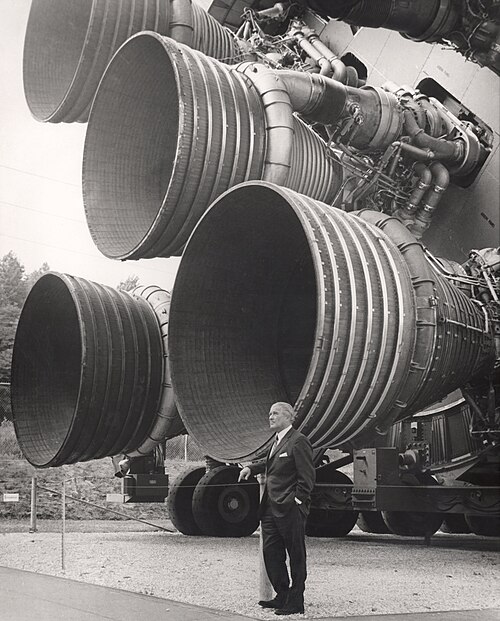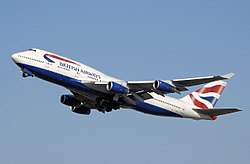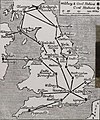Portal:Aviation
| Main page | Categories & Main topics |
|
Tasks and Projects |
The Aviation Portal

Aviation includes the activities surrounding mechanical flight and the aircraft industry. Aircraft includes fixed-wing and rotary-wing types, morphable wings, wing-less lifting bodies, as well as lighter-than-air craft such as hot air balloons and airships.
Aviation began in the 18th century with the development of the hot air balloon, an apparatus capable of atmospheric displacement through buoyancy. Some of the most significant advancements in aviation technology came with the controlled gliding flying of Otto Lilienthal in 1896; then a large step in significance came with the construction of the first powered airplane by the Wright brothers in the early 1900s. Since that time, aviation has been technologically revolutionized by the introduction of the jet which permitted a major form of transport throughout the world. (Full article...)
Selected article

The Luftwaffe became an essential component in the "Blitzkrieg" battle plan. Operating as a tactical close support air force, it helped the German armies to conquer the bulk of the European continent in a series of short and decisive campaigns in the first nine months of the war, experiencing its first defeat during the Battle of Britain in 1940 as it could not adapt into a strategic role, lacking heavy bombers with which to conduct a strategic bombing campaign against the British Isles.
Despite this setback the Luftwaffe remained formidable and in June 1941 embarked on Adolf Hitler's quest for an empire in eastern Europe by invading the USSR, with much initial success. However, the Luftwaffe's striking victories in the Soviet Union were brought to a halt in the Russian winter of 1942-1943. From then on, it was forced onto the strategic defensive contesting the ever increasing numbers of Soviet aircraft, whilst defending the German homeland and German occupied Europe from the growing Allied air forces pounding all aspects of German industry.
Having failed to achieve victory in the Soviet Union in 1941 or 1942, the Luftwaffe was drawn into a war of attrition which extended to North Africa and the Channel Front. The entry of the United States into the war and the resurgence of the Royal Air Force's (RAF) offensive power created the Home Front, known as Defense of the Reich operations. The Luftwaffe's strength was slowly eroded and by mid 1944 had virtually disappeared from the skies of Western Europe leaving the German Army to fight without air support. It continued to fight into the last days of the war with revolutionary new aircraft, such as the Messerschmitt Me 262, Messerschmitt Me 163 and the Heinkel He 162, even though the war was already hopelessly lost. (Full article...)
Selected image

Did you know
...that Communist Romania's Foreign Minister, Grigore Preoteasa, was killed in an aircraft accident after refusing to wear a seat belt during landing? ...that No. 112 Squadron RAF was the first unit from any air force to use the "Shark Mouth" logo on P-40 fighter planes? ...that Washington Senators outfielder Elmer Gedeon, who pulled a crew member from a burning wreck, died while piloting a B-26 bomber over France?
General images -
In the news
- May 29: Austrian Airlines cancels Moscow-bound flight after Russia refuses a reroute outside Belarusian airspace
- August 8: Passenger flight crashes upon landing at Calicut airport in India
- June 4: Power firm helicopter strikes cables, crashes near Fairfield, California
- January 29: Former basketball player Kobe Bryant dies in helicopter crash, aged 41
- January 13: Iran admits downing Ukrainian jet, cites 'human error'
- January 10: Fire erupts in parking structure at Sola Airport, Norway
- October 27: US announces restrictions on flying to Cuba
- October 3: World War II era plane crashes in Connecticut, US, killing at least seven
- September 10: Nevada prop plane crash near Las Vegas leaves two dead, three injured
- August 6: French inventor Franky Zapata successfully crosses English Channel on jet-powered hoverboard
Related portals
Associated Wikimedia
The following Wikimedia Foundation sister projects provide more on this subject:
-
Commons
Free media repository -
Wikibooks
Free textbooks and manuals -
Wikidata
Free knowledge base -
Wikinews
Free-content news -
Wikiquote
Collection of quotations -
Wikisource
Free-content library -
Wikiversity
Free learning tools -
Wikivoyage
Free travel guide -
Wiktionary
Dictionary and thesaurus
Selected biography
Elbert Leander "Burt" Rutan (born June 17, 1943 in Estacada, Oregon) is an American aerospace engineer noted for his originality in designing light, strong, unusual-looking, energy-efficient aircraft. He is most famous for his design of the record-breaking Voyager, which was the first plane to fly around the world without stopping or refueling, and the suborbital rocket plane SpaceShipOne, which won the Ansari X-Prize in 2004.
Selected Aircraft

The Boeing 747 is a widebody commercial airliner, often referred to by the nickname Jumbo Jet. It is among the world's most recognizable aircraft, and was the first widebody ever produced. Manufactured by Boeing's Commercial Airplane unit in the United States, the original version of the 747 was two and a half times the size of the Boeing 707, one of the common large commercial aircraft of the 1960s. First flown commercially in 1970, the 747 held the passenger capacity record for 37 years.
The four-engine 747 uses a double deck configuration for part of its length. It is available in passenger, freighter and other versions. Boeing designed the 747's hump-like upper deck to serve as a first class lounge or (as is the general rule today) extra seating, and to allow the aircraft to be easily converted to a cargo carrier by removing seats and installing a front cargo door. Boeing did so because the company expected supersonic airliners (whose development was announced in the early 1960s) to render the 747 and other subsonic airliners obsolete; while believing that the demand for subsonic cargo aircraft would be robust into the future. The 747 in particular was expected to become obsolete after 400 were sold but it exceeded its critics' expectations with production passing the 1,000 mark in 1993. As of September 2023, 1,574 aircraft have been built, with the final delivery in January 2023.
The 747-8, the latest version in service, is among the fastest airliners in service with a high-subsonic cruise speed of Mach 0.855 (564 mph or 908 km/h). It has an intercontinental range of 7,730 nautical miles (14,320 km; 8,900 mi). The 747-8I (passenger version) can accommodate 467 passengers in a typical three-class layout. The 747-8 completed production on 6 December 2022 and the final 747 was delivered to Atlas Air on 31 January 2023.
Today in Aviation
- 2023 - First flight of the Northrop Grumman B-21 Raider
- 2010 – An Israeli Air Force F-16I crashes in Makhtesh Ramon while on a training over the Negev desert in southern Israel, killing both the pilot and navigator of the plane.[1]
- 2009 – Kingfisher Airlines Flight 4124, operated by ATR 72-212 A VT-KAC skidded off the runway after landing at Chhatrapati Shivaji International Airport. The aircraft suffered substantial damage but all 46 passengers and crew escaped unharmed.
- 2008 – Ryanair Flight 4102 was a flight operated by a Boeing 737-8AS, registered EI-DYG, from Frankfurt-Hahn Airport, Germany, to Rome Ciampino Airport, Italy, that, on 10 November 2008 suffered multiple bird strikes. Of the 172 people on board, two crew and eight passengers were transported to hospital and received treatment for minor injuries.
- 2005 – The Boeing 777-200LR establishes a new world record for nonstop distance by a commercial airplane, flying 11,664 nautical miles in 22 hours and 42 min from Hong Kong to London.
- 2003 – The final flight of British Airways Concorde G-BOAD is flown from London Heathrow (LHR) to New York’s JFK, to deliver the aircraft to the Intrepid Sea-Air-Space Museum. It was JFK’s very last Concorde movement.
- 1988 – The US Air Force publicly unveils the F-117 Nighthawk
- 1982 – An Air Combat Manoeuvring Range was opened at Cold Lake. It was the first ACMR built for non-US forces.
- 1972 – Southern Airways Flight 49 from Birmingham, Alabama is hijacked and, at one point, is threatened with crashing into the nuclear installation at the Oak Ridge National Laboratory. After two days, the plane lands in Havana, Cuba, where the hijackers are jailed by Fidel Castro.
- 1971 – In the 1971 Indian Ocean Vickers Viscount crash, a Merpati Nusantara Airlines plane crashes into the Indian Ocean off Padang, Indonesia in bad weather, killing all 66 on board.
- 1970 – The first of two Russian, unmanned lunar rovers, Lunokhod 1, was launched. As mission Luna 17, the craft was the first remote-controlled robot to land on another celestial body, sending back images and data to Russia until the following September.
- 1963 – SAC Boeing WB-47E Stratojet, 51-2420, built as B-47E-60-BW and modified to weather reconnaissance variant, making emergency landing at Lajes Air Base, Azores, skids into parking ramp, strikes Boeing Boeing C-97C Stratofreighter, 50-0690, loses port inner engine nacelle (numbers 2 and 3), starboard outer nacelle (number 6) and starboard wingtip. Fire damages port inner wing above lost nacelle. Crew survives.
- 1959 – The combination of a blizzard and a blocked runway at Malmstrom AFB, Great Falls, Montana lead to the loss of three Northrop F-89 Scorpion aircraft. During a blizzard the runway was unusable due to a Lockheed T-33 Shooting Star which had sheared it's landing gear on touch down. The Scorpions and an undisclosed number of other aircraft were returning to the base low on fuel and in near zero visibility. Four were lost in two of the crashed planes while the two man crew of the third parachuted to safety. No one was injured in the T-33 incident.
- 1958 – A TCA Vickers Viscount parked at Idlewild Airport, New York while awaiting its passengers was destroyed by fire after it was struck by a Lockheed 1049D Super Constellation of Seaboard & Western Airlines which had crashed while taking off. The two crew members on board survived the accident.
- 1950 – AA USAF Boeing B-50 Superfortress of the 43d Bomb Wing on a routine weapons ferrying flight between Goose Bay, Labrador and its home base at Davis-Monthan AFB, Arizona, loses two of four engines. To maintain altitude it jettisons empty Mark 4 nuclear bomb casing just before 1600 hrs. at 10,500 feet (3,200 m) above the St. Lawrence River near the town of St. Alexandre-de-Kamouraska, about 90 miles (140 km) northeast of Quebec, Canada. HE in the casing observed detonating upon impact in the middle of the twelve-mile (19 km)-wide river, blast felt for 25 miles (40 km). Official Air Force explanation at the time is that the Superfortress released three conventional 500-pound HE bombs.
- 1949 – First flight of the Sikorsky H-19, an improved version of HRP helicopter which also will serve as H-21 Shawnee and H-21 Workhorse.
- 1945 – First flight of the Yakovlev Yak-11.
- 1943 – Boeing B-17G Flying Fortress 42-37831 suffered a hydraulics and brakes failure at RAF Snetterton Heath and was written off.
- 1942 – USS Chenango (CVE-28) flies off 75 U. S. Army Air Forces P-40 Warhawk fighters, which establish a base at Port Lyautey, French Morocco. SBD Dauntless dive bombers from USS Ranger damage the French battleship Jean Bart in Casablanca harbor.
- 1941 – First George Cross was awarded posthumously to LAC KM Gravel for his attempted rescue of his pilot from burning wreckage of a DH 82 C Tiger Moth at Calgary, Alberta.
- 1936 – U.S. Navy Aviation Cadet William H. Jones, on approach to USS Ranger in a Grumman F3F-1, accidentally flies into the foremast of plane guard destroyer. Plane and body sink in 4,600 feet of water.
- 1933 – Ronald Evans (Captain, USN Ret.), American astronaut was born (d. 1990). Evans was the command module pilot of Apollo 17, the last scheduled manned mission to the moon for the United States. As of 2007, he holds the record of more time in lunar orbit than anyone else in the world. Evans flew F-8 Crusader aircraft from the carrier USS Ticonderoga during a period of seven months in Vietnam combat operation. The total flight time accrued during his career was 5,100 hours, including 4,600 hours in jet aircraft.
- 1932 – British Prime Minister Stanley Baldwin states in a speech that “The bomber will always get through”.
- 1930 – First airline flight from New York to Panama.
- 1919 – First flight of the Blériot-SPAD S.27
- 1915 – Theodore Macauly of Toronto was the first to pilot a twin-engined flying boat in Canada.
- 1907 – Louis Bleriot introduces what will become the modern configuration of the airplane. His Blériot VII has an enclosed or covered fuselage (body), a single set of wings (monoplane), a tail unit, and a propeller in front of the engine.
- 1907 – Henry Farman becomes the first European to be airborne in a powered heavier-than-air machine for longer than Wilbur Wright‘s 59 s. on 17 December 1903 when he flies for 1 min. 14 s. He covers a distance of 1030 m (3,379 ft).
- 1904 – Wilbur Wright flies the Wright Flyer II a distance of 3 miles near Dayton, Ohio, the first flight of longer than five minutes.
References
- ^ "Bodies of IAF pilot and navigator found after F-16I crash in Negev" haaretz.com. Retrieved: 10 November 2010.
- Shortcuts to this page: Portal:Airplanes • P:AVIA



















































